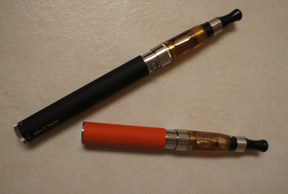Electronic cigarettes, often called e-cigs, are marketed as an alternative to cigarette smoking. They are also referred to as personal vaporizers or electronic nicotine delivery systems. These devices have a cylindrical body that holds a cartridge containing a liquid solution; some resemble tobacco cigarettes. The solution, termed “e-liquid” or “e-juice,” contains a base material, flavoring compounds, and nicotine. The base material is generally propylene glycol and either vegetable glycerin or polyethylene glycol.
reusable e-cigs

Some e-cigarettes can be reused. Photo by VIN
Glycerin and propylene glycol are of low toxicity when eaten, but the amount in the refill bottles (usually 10-30% of what's in the bottle) is low enough to not be much of a concern; nicotine is the bigger issue. Whether any of the compounds used are toxic if inhaled long term is not known.

Some e-cigarettes are disposable. Photo by VIN
The nicotine levels in these e-liquids can vary in concentration from being completely nicotine-free up to 36 milligrams per milliliter (mg/mL) of nicotine. For marketing purposes, the “/mL” part is frequently dropped, and the e-liquids are advertised as having X mg of nicotine rather than X mg/mL. In some e-cigs, the user controls the amount of nicotine delivered by adjusting the flow of e-liquid from the cartridge.
An e-cig with a full cartridge can contain up to 36 mg of nicotine, which doesn’t sound like a lot until you factor in how toxic nicotine is. Clinical signs of nicotine poisoning can be seen in dogs and cats exposed to a mere 0.5 mg per pound of body weight. For cats and small dogs, ingesting 20 mg of nicotine can be lethal.
Even more dangerous are the bottles of e-liquid that are used to recharge the e-cig cartridge: the nicotine in these bottles can range from 10 mL to 60 mL or more. So a 30-mL bottle of 36 mg/mL e-liquid will contain 1080 mg of nicotine, more than enough to prove fatal for even a very large dog if the contents are ingested.

E-juice is bottled. Photo by VIN
Nicotine is readily absorbed by ingestion as well as through the skin. Pets may be exposed when they chew up the e-cigs or the bottles containing e-juice or even when they walk through puddles of spilled e-juice and get it on their paws. The signs of nicotine poisoning may begin within 15 to 30 minutes of exposure to the e-liquid; in contrast, signs of nicotine poisoning following eating tobacco products may take a few hours as the nicotine must be released from the tobacco.
The first signs normally seen with toxic exposure to nicotine include:
- Excessive drooling (hypersalivation)
- Vomiting with or without diarrhea
- Agitation or restlessness
- Increased respiratory rate or panting.
With severe intoxications, signs may progress to include:
- Excitation
- Disorientation
- Tremors
- Twitching
- Convulsions or seizures
- Increased heart rate
- Increased blood pressure.
Further progression of signs may result in profound weakness, paralysis, abnormal heart rhythms (including cardiac arrest), hypotension, coma, and death.
Prompt and aggressive veterinary care is required to successfully manage poisoning from e-juice exposure. Because the e-juice is rapidly absorbed across the mucous membranes of the mouth, standard decontamination measures such as inducing vomiting are usually not helpful. Treatment includes managing convulsions and seizures, treating heart and blood pressure abnormalities, ensuring adequate respiration, and providing intravenous fluids to enhance nicotine elimination.
The prognosis for patients exposed to large amounts of nicotine can be quite grave depending on how quickly veterinary care is obtained, and even with aggressive veterinary care, some patients will not survive.
The ASPCA National Animal Poison Control is available 24 hours a day at 888-426-4435. Expect an initial consultation fee of around $100.00 and additional follow-up is at no charge. You will be assigned a case number your veterinarian can use to communicate with a toxicology specialist before beginning treatment.
If your pet has a HomeAgain microchip, a free poison control consultation is included in the full-service registration. Call 1-888-466-3242.
https://www.homeagain.com/our-services/emergency-medical-hotline
https://www.aspca.org/pet-care/animal-poison-control